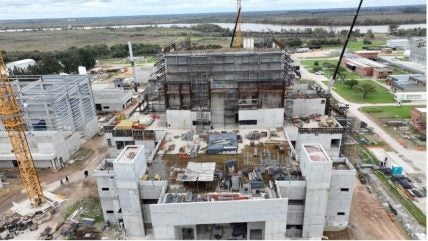
Construction of Argentina’s CAREM-25 small modular reactor (SMR) has once again been stopped, this time by layoffs of construction workers. Some 153 people were laid off, taking the total number of firings to 470 since the beginning of the year. According to the Buenos Aires Herald, the layoffs were carried out by the three private construction contractors in charge of the project due to lack of sufficient funding from the government.
According to construction union representatives, CAREM’s construction is 85% complete and was set to go online in 2028, before the latest stoppage.
In October 2023, Argentina’s National Atomic Energy Commission (CNEA – Comisión Nacional de Energía Atómica) and Nucleoeléctrica Argentina SA (NA-SA) signed a framework agreement for technical assistance to develop CAREM (Central ARgentina de Elementos Modulares) – Argentina’s first domestically-designed and developed 32 MWe nuclear power unit. As well as relying on passive safety systems, CAREM’s entire primary coolant system is contained within the single self-pressurised vessel and uses free convection to circulate the coolant. This eliminates the need for devices such as pumps within the primary circuit and decreases the extent and complexity of the piping system required, as well as reduces the possibility of accidents involving a loss of coolant.
Development started in 1980 by CNEA and technology company INVAP and it was first announced in 1984. Progress slowed in the early 2000s but a 2006 government decree made the CAREM programme a national priority. A second executive order in 2008 made the project directly responsible to the President of Argentina.
Initially, CAREM-25 was expected to start up in 2017, but this was put back to 2020. Then, in 2019 contractor Techint Engineering & Construction stopped work alleging late payment from the government among other delays. In April 2020, it was announced that construction was to resume. In mid-2020, a “transition” contract was signed, allowing he CAREM Works Directorate Management and the Nuclear Project Management Unit of NA-SA to reactivate the project and reinstate workers who had been laid off.
In mid-2021, a contract was signed whereby NA-SA resumed execution of construction, under the direction of CNEA allowing 36 months to complete the reactor building. The Technical Assistance Framework Agreement between CNEA and NA-SA, with a duration of two years, extendable by mutual agreement, provides the general framework to enable contracts related to CAREM. The October 2023 framework agreement led to optimism that the project would finally be completed. At that time, about 1,400 people were working on the project, including CNEA staff and suppliers and there were 160 contracts in force, mostly with Argentine companies.
However, the election of right-wing Javier Milei as President in November 2023 ushered in radical economic reforms including cuts in public spending and social unrest. The CAREM project fell victim to this and the 2028 launch date is now looking uncertain. In addition to the layoffs, CNEA recently announced that it had decided to put the building stage on hold and focus on an “engineering revision stage”.
CNEA president Germán Guido Lavalle said that construction is “essentially finished” and remaining details “will be completed over the next few years”. The release added that the project will need new funds in the future and that CNEA will continue to work alongside the government with a focus on engineering instead of construction.
“Works for the modular nuclear reactor CAREM are in place and have not stopped,” a CNEA communiqué stated. “The project is in an advanced building stage and contracts related to those tasks are coming to an end,” they added, referring to the layoffs.
However, CNEA was not assigned a budget for this year and has been using an extension of the 2023 one. In March, the government renewed all state employee contracts for only three months. At that time, CNEA managers called the situation “critical” in an internal document, warning that the budget could last only until May or June.
“We were expecting this. We knew the budget for this year would not be enough to continue with the project,” said Adriana Serquis, former head of the CNEA who left her post in May due to ideological differences with the Milei administration. She is now the director of CNEA’s Nanoscience and Nanotechnology Institute.
“The lack of funding led to part of the construction stage being halted, and it all comes down to a budget issue,” Serquis said. “Even if [CNEA] says the project will continue, it will be very slow. During that time, they won’t be able to guarantee that qualified staff will stay and achieve the goal of being one of the first countries to have this kind of reactor.”
The decision to lay off experienced workers also affects development of Argentina’s nuclear industry overall. According to Julio González, a construction union leader in Zárate, where the reactor is being built, there are only 160 builders still in position and this will be reduced to 30 by November. “They have acquired knowledge in building nuclear reactors,” González told the Buenos Aires Herald. “Halting the project means older workers who are close to retirement age will not be able to transfer their knowledge to newer generations.”
For Serquis, the situation regarding the loss of professionals is serious. “We are now scared that engineering teams will fall apart. It’s very hard to put them back together,” she warned. “It’s a mixture of sadness, anger, and helplessness.”
Argentina’s Tres Lineas said “the dismantling of nuclear policy is progressing rapidly. Workers from several different unions such as Uecara and Uocra, ATE and Luz y Fuerza, protested by blocking National Route 9. ATE said the excuse being given is engineering problems when they understand that in reality the problem is “the brutal adjustment that the Milei government is making which is being carried out by the authorities of the National Atomic Energy Commission”.






